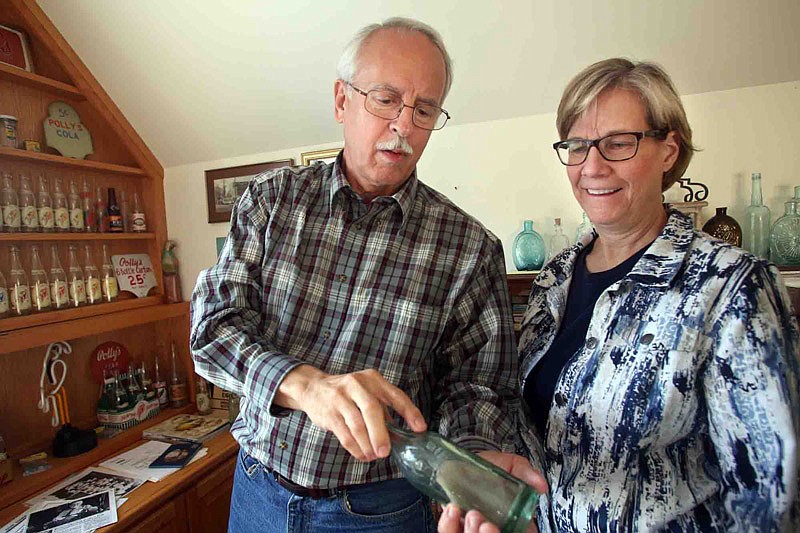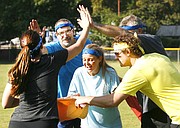Cradling a fragile, ornate glass bottle, Randee Kaiser beams with pride as he weaves the bottle's tale of origin and design.
The local bottle collector can talk about the the evolution of glass manufacturing methods or the local, often short-lived, history of bottling companies.
Not all collectors become historians. For Kaiser, he said he simply was curious.
"Every bottle has a story, even the short-lived companies," he said.
He knows where the term pop came from - the early Hutchinson stopper made a pop sound when forced inside the bottle for opening. When the familiar crown cap was developed, bottling companies had to provide instructions for how to use the bottle opener tool, he added.
The nearly 30-year hobby has been a consuming interest for Kaiser and his wife, Sue. They travel across the nation to nearly a dozen bottle shows each year.
They have a reputation within bottle collector circles. For some with specific design interests - like bears or cowboys - the couple might keep a look out for friends. Or, if they make a new purchase, other collectors will be calling to see what they may be moving out of their personal collection.
"We enjoy helping people grow their collection, too," Randee said.
They are the only serious collectors around Jefferson City. The next nearest collector they know of is in Boonville, and the nearest bottle collectors' club is in St. Louis.
"We've met some of the most wonderful and interesting people from across the country," Sue said.
Among their collection of approximately 350, the favorites sit neatly on a specially designed wall shelf in their living room, and duplicate Polly Pop bottles provide special decoration in their kitchen. The "holy grail," though, lines the wall of the upstairs office - a variety of Missouri-specific manufacturers on one side and their beloved Polly Pops filling the other side.
The Independence-based bottling company is the couple's primary interest, or subcollection.
They have the company's bottles in several different colors and throughout its bottling history. They also have several "go-withs," the non-bottle items related to the product, such as signs, bottle toppers or six-pack cartons.
The Kaisers also happen to have a front bumper with logo off of one of the Independence-based delivery trucks. And they have binders filled with advertisements - a new one every day for decades - from the Independence Examiner recovered from microfilm.
The Polly Pop parrot emblem honored the owner's nickname, which was the result of Lewis Compton's childhood concern for a barber's pet parrot that did not survive a shop fire, Randee said.
"His friends and parents started calling him 'Polly,'" he said.
Compton bought the Independence Bottling Company in 1922, buying out his partner in 1923 and ordering clear bottles with a parrot embossed at the shoulder. The product became Polly's Soda Pop in 1939, and bottle labels boasted a painted color parrot.
Polly's Soda Pop closed in 1967.
The company held a reunion in June 1994, to which the Kaisers were invited to share their collection. In return, they enjoyed collecting first-hand stories from family and former employees.
"It's nice you can have something you're a caretaker for," Randee said.
Among bottle collectors, the three main factors for monetary value are rarity, unique design and condition.
However, the Kaisers agree sometimes a bottle is just nice to look at or has a personal story that attracts a collector with its intangible value.
When they're at a show, all of these facets come into play until that unique bottle grabs their attention.
"It's one of a kind; we may never see it again; and we're not finished looking at it, so we have to take it home," Randee said.
Perusing their favorites in their home display, only one bottle does not have a detailed picture. It simply says "Sweet Mandy" in red Oriental font on a white label over a ribbed bottle.
There are recurrent themes on these small-time bottle designs, such as glamour girls, flowers or local landmarks.
The designs also can tell stories.
A bottle from the City of Roses, Texas, features its namesake; and a Huntsville, Alabama, (where the NASA Space Camp is located) company used a rocket ship.
One from Zanesville, Ohio, depicts not only the city's unique Y-bridge but also kilns representing its nickname as "clay city." Then there's the controversial, risque image of a woman showing her belly button by the Cleo Cola of St. Louis.
Collectors of other forms of art as well, the Kaisers see their collection as a medium of Americana art.
"It represents who we are, our ideals, our heroes," Randee said.
Some collectors have Butler buildings strictly to store their precious pieces.
However, the Kaisers have reached the point where they maintain a manageable number.
"We want to keep them out where we can see them," Sue said.
So when they add to their collection, they also subtract.
Two bottles they likely never will part with are the first of Randee's collection.
More than 40 years ago, he was given an old red and white Pepsi, bottled in Joplin.
"I thought it was cool, so I sat it on my desk," he said. It moved with him from job to job.
Years later, while waiting for a meeting in Boonville, he stopped into an antique store where he saw a green and white labeled soda bottle in an art deco style and featuring the Excelsior Springs spa.
"I thought it looked really cool next to the Pepsi bottle then I wondered if I could find a blue and white one," and the collection was born.
That was 1988. Four years later, he met Sue, and the collection became theirs. When they filled a bookcase, they bought another bookcase.
At that time, antique shops and individual collectors were the primary sources.
Then, "eBay changed the face of all collecting," Sue said.
In the same way, marketing changed the face of the bottling industry.
In the last 200 years, there have been nearly 15,000 soda companies in the United States. Most of them were "mom and pop," small-town operations, and the vast majority are long gone, Randee said.
Even communities like Meta and Chamois had their own, local bottling company.
"Americans have a sweet tooth, so soda was very popular," he said.
Growing up in Webb City, Randee said he was fond of drinking RC Cola. However, "Coke is the master," he said.
Working at a local grocery story as a teenager, Randee said, he often was tasked with sorting the glass deposits.
"I wonder how many treasures I threw away," he said.


